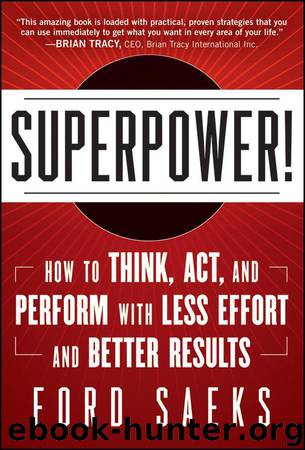Superpower: How to Think, Act, and Perform with Less Effort and Better Results by Ford Saeks

Author:Ford Saeks [Saeks, Ford]
Language: eng
Format: mobi
Publisher: Wiley
Published: 2012-05-15T14:00:00+00:00
Is Multitasking Worth Dying For?
One great example of what I'm talking about is the epidemic of texting while driving that we've got now. We taught ourselves to do that. When we have to put up billboards on the highways to remind us that we're not supposed to be writing notes to each other at the same time we're steering a two-ton piece of heavy equipment down a crowded interstate, then we know we've got a problem with learned ADD.
Delusion on the Road: A Matter of Life and Death
“I can check my messages while I'm driving. It only takes a few seconds.”
Really?
Text-messaging creates a crash risk 23 times worse than driving while not distracted. (VTTI)
In 2011, 5,474 people were killed in crashes involving driver distraction, and an estimated 448,000 were injured. (NHTSA)
Sixteen percent of fatal crashes in 2009 involved reports of distracted driving. (NHTSA)
Twenty percent of injury crashes in 2009 involved reports of distracted driving. (NHTSA)
In the month of June 2011, more than 196 billion text messages were sent or received in the United States, up nearly 50 percent from June 2009. (CTIA)
Teen drivers are more likely than other age groups to be involved in a fatal crash where distraction is reported. In 2009, 16 percent of teen drivers involved in a fatal crash were reported to have been distracted. (NHTSA)
Forty percent of all American teens say they have been in a car when the driver used a cell phone in a way that put people in danger. (Pew)
Drivers who use hand-held devices are four times more likely to get into crashes serious enough to injure themselves. (Monash University)
Sending or receiving text takes a driver's eyes from the road for an average of 4.6 seconds, the equivalent (at 55 mph) of driving the length of an entire football field, blind. (VTTI)
Headset cell phone use is not substantially safer than hand-held use. (VTTI)
Using a cell phone while driving—whether it's hand-held or hands-free—delays a driver's reactions as much as having a blood alcohol concentration at the legal limit of 0.08 percent. (University of Utah)
Driving while using a cell phone reduces the amount of brain activity associated with driving by 37 percent. (Carnegie Mellon)
(Source: National Traffic and Highway Safety Administration.)
So lesson number one is pretty straightforward: Put the freaking phone down when you're driving. Your technology is not worth dying for…or killing someone for. I can tell you that, as a cyclist, I've been almost run over dozens of times by distracted drivers. I don't know which is worse, drunk driving or driving while texting. All I know is that you shouldn't do either one.
Download
This site does not store any files on its server. We only index and link to content provided by other sites. Please contact the content providers to delete copyright contents if any and email us, we'll remove relevant links or contents immediately.
The Compound Effect by Darren Hardy(8727)
Tools of Titans by Timothy Ferriss(8149)
Nudge - Improving Decisions about Health, Wealth, and Happiness by Thaler Sunstein(7456)
Win Bigly by Scott Adams(7031)
Deep Work by Cal Newport(6813)
Rich Dad Poor Dad by Robert T. Kiyosaki(6311)
Pioneering Portfolio Management by David F. Swensen(6167)
Principles: Life and Work by Ray Dalio(6116)
The Barefoot Investor by Scott Pape(5645)
Digital Minimalism by Cal Newport;(5582)
Grit by Angela Duckworth(5446)
The Slight Edge by Jeff Olson(5314)
Discipline Equals Freedom by Jocko Willink(5237)
The Motivation Myth by Jeff Haden(5119)
You Are a Badass at Making Money by Jen Sincero(4727)
The Four Tendencies by Gretchen Rubin(4510)
Eat That Frog! by Brian Tracy(4377)
The Confidence Code by Katty Kay(4154)
Bullshit Jobs by David Graeber(3988)
